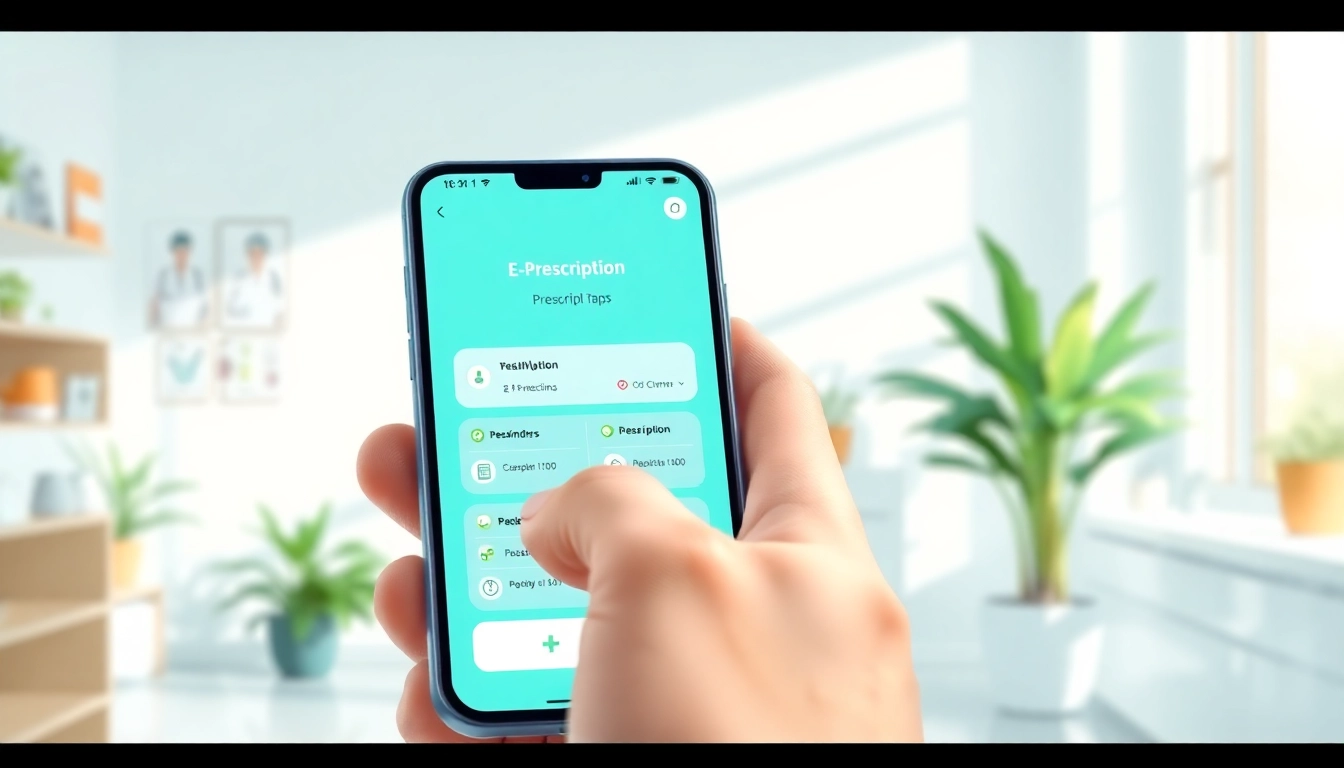Introduction to E-Prescription Apps
In recent years, the healthcare landscape has undergone significant transformations, driven largely by advancements in technology. Among these innovations, e-prescription apps have emerged as a vital tool for both healthcare providers and patients. These digital solutions allow physicians to electronically send prescriptions directly to pharmacies, streamlining the medication dispensing process and enhancing overall healthcare efficiency. In this article, we will delve deep into the advantages of using eprescription apps, exploring their myriad benefits and how they are reshaping the patient care experience.
Defining E-Prescription Apps
E-prescription apps are software applications that facilitate the electronic transmission of prescriptions from healthcare providers to pharmacies. They replace traditional paper prescriptions with digital records that can be quickly accessed and managed. This technology plays a critical role in modernizing the healthcare industry, allowing for greater accuracy, security, and efficiency in prescribing medications.
How They Work in Healthcare
When a doctor prescribes medication, they enter the prescription details into an e-prescription app. This information is then transmitted electronically to the patient’s chosen pharmacy. The pharmacy receives and validates the prescription, ensuring it meets all necessary guidelines before dispensing the medication. This process eliminates the need for physical paperwork and reduces the chance of errors associated with handwritten prescriptions.
Backdrop of Digital Transformation in Medicine
The rise of e-prescription apps is part of a broader trend toward digital transformation in medicine. With the increasing digitization of health records and patient management systems, e-prescribing is now an integral component of electronic health records (EHRs). This shift is driven by the desire for improved patient outcomes, enhanced operational efficiency, and lower healthcare costs.
Advantages of Using E-Prescription Apps
Streamlined Workflow for Healthcare Providers
One of the most significant advantages of using eprescription apps is the streamlined workflow they offer healthcare providers. By automating the prescription process, these apps significantly reduce the time spent on administrative tasks. Healthcare professionals no longer need to deal with illegible handwriting or misplaced paper prescriptions. E-prescription apps allow for quick updates to patient records and immediate feedback from pharmacies.
The integration of e-prescribing into EHR systems further optimizes workflows, enabling a seamless transition of patient data between different systems. This efficiency not only improves the workflow for healthcare providers but also enhances the overall patient experience, shortening wait times and reducing the likelihood of errors.
Improved Medication Adherence for Patients
Medication adherence is crucial for effective treatment, yet many patients struggle to follow their prescribed regimens. E-prescription apps assist in improving medication adherence by providing patients with reminders and educational resources about their medications. Studies show that when patients are actively engaged and informed, they are more likely to adhere to their prescribed treatments.
Additionally, the convenience of e-prescription apps enables patients to manage their prescriptions more effectively. They can easily request refills, check the status of their medications, and receive notifications when it’s time to pick up their prescriptions. This accessibility not only empowers patients but also directly contributes to better health outcomes.
Enhanced Communication Between Patients and Providers
Effective communication between patients and healthcare providers is essential for optimal care. E-prescription apps enhance this communication by allowing direct messaging functionalities and access to medication histories. Patients can easily reach out to their providers with questions or concerns related to their prescriptions, fostering an open dialogue.
Moreover, these apps can facilitate follow-up communication post-medication, enabling healthcare providers to assess the effectiveness of prescribed treatments and make necessary adjustments. By nurturing this relationship, providers can build trust with their patients, leading to improved overall satisfaction with the healthcare experience.
Impact on Patient Safety and Care Quality
Reducing Medication Errors with Technology
Medication errors can have severe consequences, making the safety of the prescribing process a top priority. E-prescription apps greatly minimize the risk of medication errors by eliminating factors such as poor handwriting and lost prescriptions. When medications are prescribed digitally, the potential for miscommunication significantly decreases.
The incorporation of drug interaction checks and dosage calculators within these apps further enhances safety. Healthcare providers can be alerted to potential drug interactions or contraindications, allowing them to make informed decisions and choose the best treatment options for their patients.
Access to Comprehensive Medication Records
Another crucial benefit is the accessibility of comprehensive medication records. E-prescription apps store detailed information about patients’ medications, including dosage, timing, and prescribing physician. This centralized record allows healthcare providers to have a complete view of a patient’s medication history, simplifying the management of chronic conditions and ensuring continuity of care.
This level of access prevents issues related to polypharmacy, where patients are prescribed multiple medications, increasing the risk of adverse reactions. By having a consolidated view of a patient’s medications, providers can more effectively manage treatment plans and enhance patient safety.
Real-Time Monitoring and Alerts
Real-time monitoring and alerts are transformative features of e-prescription apps. They provide immediate feedback on prescription refills, patient adherence, and potential medication issues. For instance, providers can receive alerts if a patient has not filled a prescription within a specified period or if there are updates regarding medication availability at a pharmacy.
This proactive approach allows for timely interventions, ensuring that patients receive necessary medications on time and adhere to their treatment plans. It also helps providers stay informed about their patients’ progress, enabling ongoing support and adjustments to care plans as needed.
Challenges and Limitations of E-Prescription Apps
Potential Barriers to Adoption
Despite the numerous advantages, the adoption of e-prescription apps is not without its challenges. One notable barrier is the resistance to change among healthcare providers who may be accustomed to traditional prescribing methods. Training and implementation strategies must be well-structured to encourage acceptance among users.
Furthermore, the integration of these apps into existing healthcare infrastructures, particularly in smaller practices, can be costly and logistically complex. Stakeholders must address these concerns by providing adequate support, resources, and training to ensure smooth adoption.
Addressing Privacy Concerns in Digital Health
With the digitalization of health records comes the responsibility of safeguarding patient privacy. The collection and transmission of sensitive patient information require stringent security measures to prevent data breaches and maintain trust. E-prescription apps must comply with regulations, such as the Health Insurance Portability and Accountability Act (HIPAA), to protect patient data.
Healthcare organizations must prioritize robust cybersecurity measures and ensure that all staff members are trained on best practices for handling patient information to minimize privacy concerns.
Ensuring Accessibility for All Patients
While technology plays an essential role in healthcare innovation, it is crucial to ensure that all patients can access and benefit from e-prescription apps. Digital literacy can be a significant barrier, particularly for older patients or those without reliable internet access. Healthcare providers must be aware of these challenges and consider the demographics of their patient populations when implementing e-prescribing solutions.
Offering alternatives for patients who may struggle with technology—such as providing support through pharmacy staff or utilizing legacy systems—can help ensure that no one is left behind in the digital transition.
Future Trends in E-Prescription Technology
Innovative Features on the Horizon
The future of e-prescribing is a landscape ripe for innovation. Emerging technologies such as artificial intelligence (AI) and machine learning are beginning to play a role in enhancing e-prescription functionality. These technologies can analyze patient data to suggest personalized medication regimens and alerts providers to potential complications based on patient history.
Additionally, e-prescription apps are likely to incorporate advanced analytics tools that allow healthcare organizations to assess the effectiveness of various treatments based on real-world data, leading to more informed prescribing decisions.
Integration with Telehealth Services
Telehealth services have gained significant traction in recent years, especially in light of the global health landscape changes. The integration of e-prescribing with telehealth solutions allows for seamless patient interactions—patients can receive consultations, and prescriptions and follow-ups, all in a digital environment.
This synergy between e-prescribing and telehealth enhances patient convenience and expands access to healthcare, allowing patients to obtain necessary medications without needing to visit a healthcare facility physically.
Shaping the Future of Patient-Centered Care
The evolution of e-prescription apps is setting the stage for patient-centered care, where the focus shifts to delivering personalized treatment options that cater to individual patient needs. As technology continues to advance, we can expect an increasing emphasis on patient engagement, where apps facilitate two-way communication and patient empowerment in their healthcare decisions.
The goal is not just to prescribe medication but to provide comprehensive care that supports patients in managing their health effectively. The future of e-prescribing is bright, with endless possibilities for enhancing patient outcomes and optimizing healthcare delivery.



